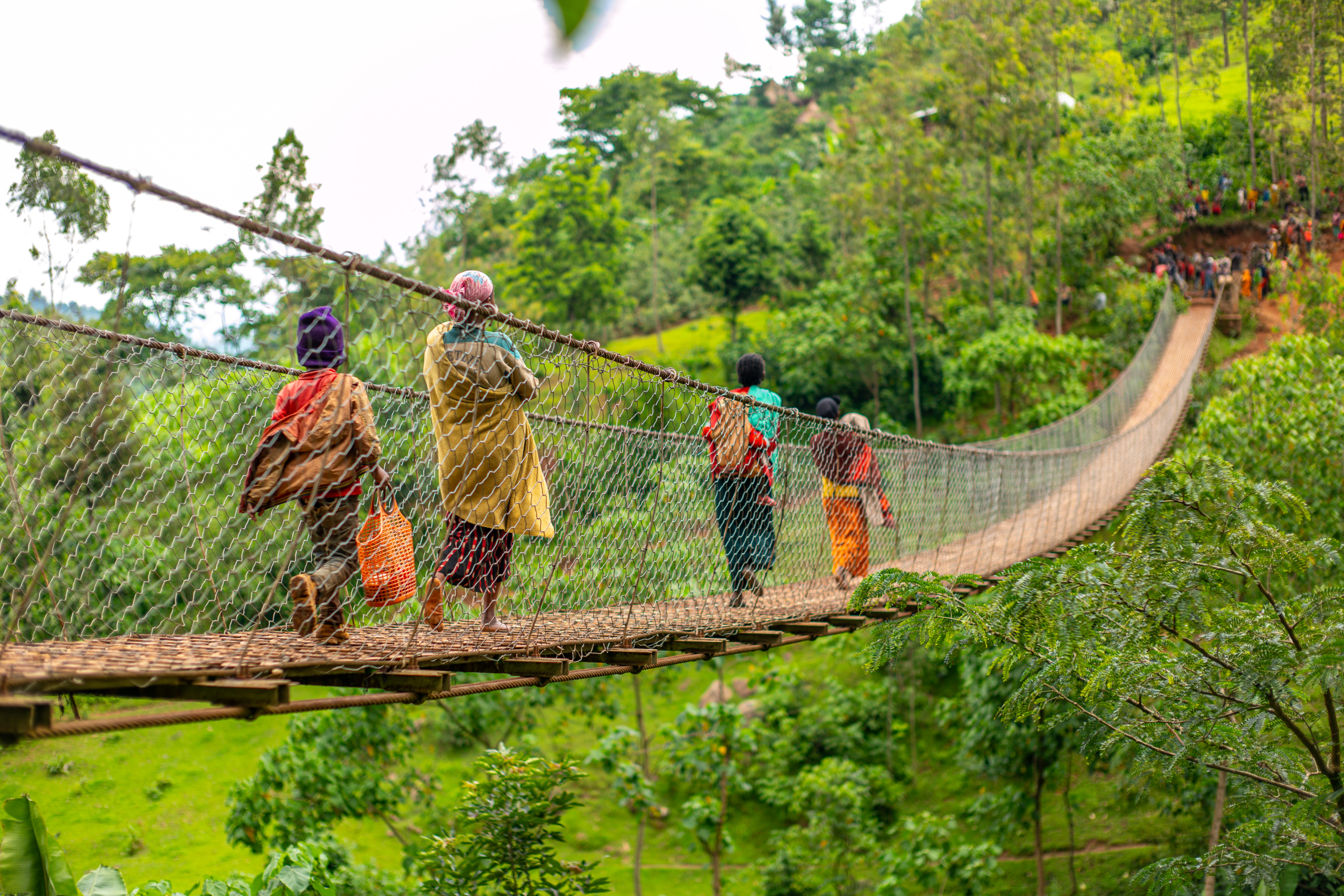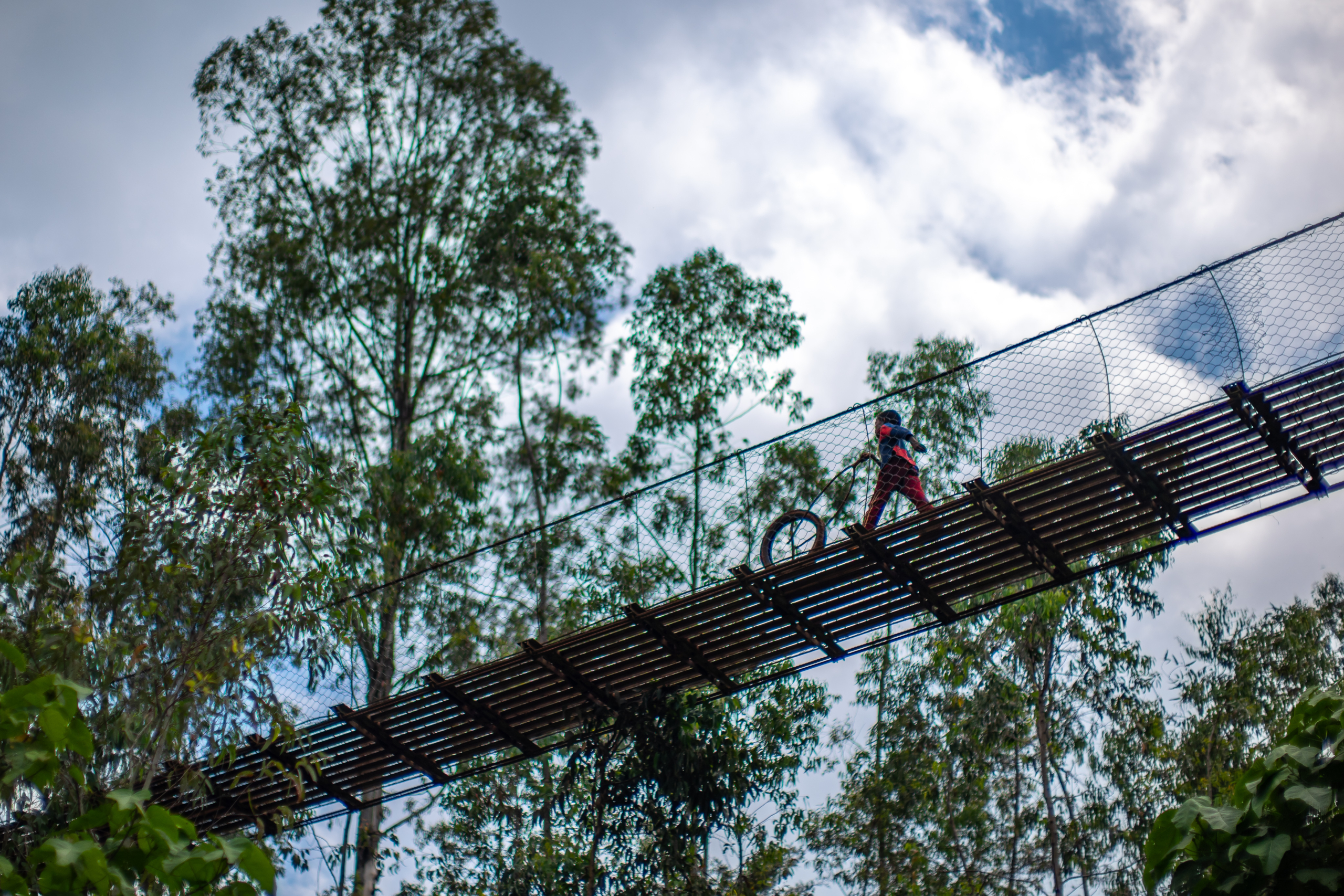
In Ethiopia, the vast majority of the population lives in the rural countryside, and people often undergo long treks on foot, bicycle, or motorcycle in order to reach schools, medical facilities, and markets. During periods of heavy rain, rivers or gorges become impassable and cut communities off from broader networks. Since 2001 Bridges to Prosperity, headquartered in Kigali, Rwanda, has been building trail bridges for isolated communities that offer safe passage over rough terrain in all weather conditions. In 2022, Helmsley provided a $10 million grant to the nonprofit for a three-year project in Ethiopia to build 150 trail bridges and create long-term capacity for national scaling.
Many countries in sub-Saharan Africa face similar challenges, and the experience of bridge building in Ethiopia sheds light on key questions about rural access, opportunity, and systems change. Here, Nivi Sharma, CEO of Bridges to Prosperity, and Walter Panzirer, Helmsley trustee, reflect on why bridge building is transformative and what kind of collaboration can successfully connect isolated communities.
A lot of Helmsley’s grants have supported organizations working in rural communities in sub-Saharan Africa and elsewhere. Why does Helmsley have this focus on rural communities?
Walter: I feel a deep connection to rural communities, having lived in rural areas much of my life. Serving as a first responder in both rural and urban areas, I developed a firsthand understanding of the connections and differences between the two. I see the need for greater access – to jobs, to healthcare, to schools – and I worry about this. Rural America is different from sub-Saharan Africa, of course, but the challenge of access to services and opportunities that help people thrive, along with the impact of distance on people’s lives, are common denominators.
In sub-Saharan Africa, the access gap between urban and rural communities is wider, and the potential benefits of connection are even greater. But there won’t be leaps in access to jobs, healthcare, or schools unless we start to solve some of the basic challenges of connecting more easily with other communities.
Rural communities across the globe provide the food we eat and the energy and natural resources we rely on, yet have access to limited resources. We can make this right, and Nivi and Bridges to Prosperity are working to build the foundation for change.
Can you talk about the significance of access, and specifically rural access? How has that influenced your career?
Nivi: In my 20s, I was an ed tech entrepreneur in Kenya and created this digitized curriculum for primary school students. And the heads of schools would say, “This is great, but we don’t have a tablet, lady. We don’t have computer labs. We don’t even have electricity.” So, I ran into this barrier of infrastructure and access right from the beginning. I moved to solving for impact and built a digital, solar-powered classroom-in-a-box filled with content and connectivity. That was the first time any sort of hardware had been designed with a rural Kenyan classroom in mind.
From there, I moved to “What about just connectivity?” My career has moved from education to hardware to connectivity, but access has always been the question we’re asking. If you can’t get online to find a job or to do a course, what are the barriers? Is it that you don’t have a signal? Is it that you don’t you can’t afford it?
Connection is foundational. Whether you’re building schools, distributing vaccinations, or building health clinics, people being able to safely get there results in multi-dimensional impact. The need is so big.
There are nearly one billion people around the world who live in rural, isolated areas in low-income countries. Improving their access to roads and transportation are the foundational building blocks before we can unlock better health, education, and economic outcomes.

Pedestrians crossing the Urago trail bridge in Shebedino woreda in the Southern Nations, Nationalities, and Peoples’ Region of Ethiopia.
What led you to fund Bridges to Prosperity, and how does this fit into Helmsley’s other work in sub-Saharan Africa?
Walter: In sub-Saharan Africa, we take a holistic approach and view our grantmaking through the lens of resilience. What do communities need to grow stronger so that they are better positioned both to thrive day-to-day and to bend without breaking when a crisis hits? Figuring this out means that we can have the most impact as a funder.
While access to quality healthcare is a Helmsley focus, we know that health and healthcare are closely linked to other aspects of development. As grantmakers based thousands of miles away, our goal is to listen to local leaders, understand what their communities need to build resilience and thrive, and provide them with the resources to make that happen.
We are invested in the work of Bridges to Prosperity because they offer an essential part of the scaffolding that makes better health—and so much else—possible. If you do not have easy access to clean water and sanitation, if you have to travel long distances for medical care, or if your farm is struggling financially because you cannot reach larger buyers, it is that much harder to be healthy and flourish. It is that much harder to rebound after a crisis.
From the work that Nivi and her team have done, we know communities that receive a trail bridge are healthier overall because visits to health clinics go up. Vaccination rates jump by 45 percent. Women spend less time on housework; we see a 60 percent increase in women entering the labor force. Farm profits grow by 75 percent. More than 30 percent of rural households must cross a bridge to reach school. A trail bridge boosts school attendance rates for girls by 200 percent—that’s a massive increase! The evidence is overwhelming: developing rural transport opens the door to new opportunities and new successes.
How does Bridges to Prosperity work? What has your organization learned after building more than 500 bridges around the world?
Nivi: When people ask how we do our work, the thing that makes me fall in love with this organization day after day is how deeply committed we are to the community. We’re not just talking to them about one aspect of their life: their agriculture, their education, or their health care. We’re just talking to them, like, “Where do you want to go? What would that do for your lives?”
We’ve spent the past 10 years getting really good at standardizing our bridge designs and our operations. Our focus now is on replication, recruitment, and enablement.
We’ve evolved from projects (“Let’s go build a bridge in Nicaragua”) to programs (“Let’s do a randomized control trial in Rwanda.”) And now we’re focusing on solving the problem, which is where funders like the Helmsley Charitable Trust are invaluable—funders that are sophisticated enough to get systems change. How do we go into a country and not say “Let’s put our boots on and construct 1,000 bridges for this country,” but instead, “How do we embed local ownership? How do we go to the private sector, the public sector?”
We don’t want to have built the most bridges in the world; that would be a huge failure on our part. We want to create an enabling environment for the most bridges to be built. We want to reach every engineering student in the country so that when Bridges to Prosperity leaves, this system we have left in place is ready and able and willing to build more and more bridges.
Our TRAIL (Transformative Rural Access for Improved Livelihoods) project in Ethiopia is groundbreaking. It gets us to share everything we’ve learned about how to build a bridge that is quick to roll out in eight to 12 weeks. We know where to build them, and we know who should be building them with trained private sector partners. We’ve helped governments adopt the right standards. We’ve worked with universities in Ethiopia to change the engineering curriculums.
This is a case study for all other countries. It’s 13,000 people per bridge that we’re serving, so the scale is huge. And the amazing thing is that beyond this TRAIL project that Helmsley has funded, the Ethiopian government has committed $5 million towards bridge building. That’s a huge, undeniable success story.
The work used to be with our own hands, and now it’s about recruiting and enabling other doers and payors at scale.

The Urago trail bridge shortens travel time and provides locals with easier access to a health clinic.
What’s next for B2P? What will it take to increase access for more rural communities across Africa?
Nivi: What’s next is not just about bridges or not just about trail bridges. Because when you ask, “Where are you trying to get to?” the answer isn’t always “I need a bridge to get there.” We want to be thinking more about rural access. Beyond bridges, there are so many rural interventions to help people get from A to B.
Next for Bridges to Prosperity is thinking broader around how we’re advising governments and serving communities. We’re excited for the potential to go to other countries. Just last week, we got an invitation from the government of Kenya to do a needs assessment in five counties. We’re really excited. And even after doing the Helmsley-funded needs landscape analysis in Zambia, the government comes knocking on our door. I think that’s a really good sign of where we’re going next.
What message do you have for other donors about programs like Bridges to Prosperity?
Walter: I am so impressed by the impact that Nivi and her team have made. They’ve been so thoughtful about how and where they’ve constructed bridges and about ensuring sustainability for the model by training others how to do what they’ve done. They are so generous with their expertise, and that’s so refreshing. And they are definitely onto something huge in terms of impact—the trail bridges they’ve built have enabled countless people to access healthcare, job opportunities, and education. Those communities have seen major increases in vaccination rates, farm profits, and school attendance for girls—this cuts across so many aspects of rural life. These are the kinds of changes that enable people to be full participants in the global economy.
I am even more inspired by Nivi’s vision for and commitment to systems change. With true partnership across the private and public sectors, we have the ability and the opportunity, if we work together, to solve the problem of rural access in our lifetime.
This is what philanthropy can do best: Tackle the big problems one step at a time. Go where no one is yet doing work. Invest in long-term change for communities. We and other philanthropies all need to continue to go after what may seem to be intractable challenges by having our eyes open to see the opportunity in something as simple yet transformative as a trail bridge.
Photos by Rob Hohmann Photography